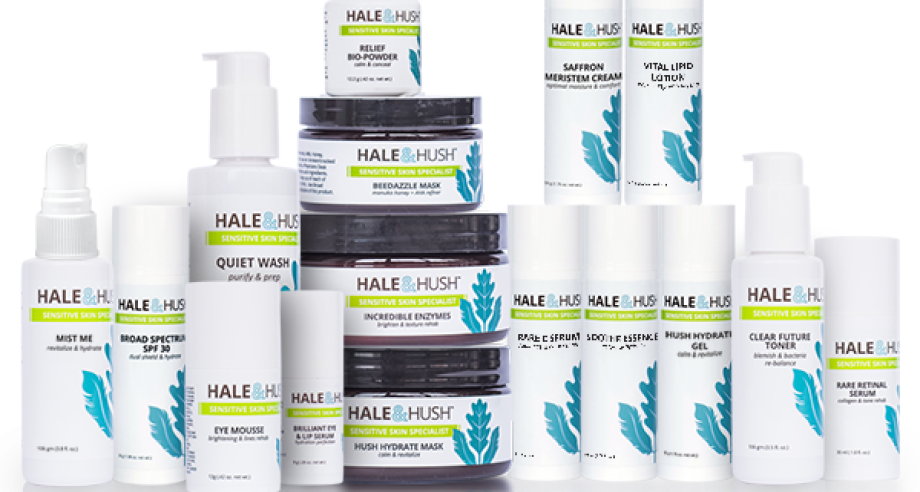“INSIDE SURFACTANTS | Hale and Hush ” – Surfactant Cleanser Examples Mackadet DA (INCI: Sodium C14-16 Olefin Sulfonate (and) Sodium Cocoamphoacetate (and) Cocamidopropyl Hydroxysultaine) is a product of Solvay. EcoSense 1200 (INCI: Lauryl Glucoside) is a product of Dow Chemical Company. Sodium Lauryl Sulfate (SLS) TEA Lauryl Sulfate Sodium Laureth Sulfate (SLES) The term surfactant is a shortened form of the phrase surface active ingredient. A surfactant is categorized as a compound that will lower the surface tension between two other factors. This could be lowering the interfacial tension between a liquid and a solid, a liquid and a gas, or even a liquid and another liquid. An example of this would be mixing oil and water in a skincare product. As we know, oil and water do not dissolve when combined, so a surfactant will then be added to a formulation to keep it from separating into layers of ingredients. Most people think this only pertains to ingredients that foam or cleanse. However, surfactants can also be in the following beauty products: emulsifiers in creams and lotions, conditioning agents in skin and hair care products, and solubilizers for perfumes and flavors. Learning the various types of surfactants and some common names helps us understand why these ingredients are used in a formula, but also why maybe a particular product is or is not working for your client and their skincare concerns. Cleansing and Foaming Surfactants as cleansing agents found in soaps and shampoos will draw the oil and dirt to the surfactant. As the surfactant is rinsed away from hair or skin, the surfactant is removed from the surface with oil/ dirt trapped inside. Consumers tend to believe that if a product foams a lot, then it cleans the skin better; however, it is more of an aesthetic property than having the ability to clean the skin more effectively. There are also several products in the marketplace, such as cleansers and shampoos, that are already in a foaming form. The surfactant in the foaming agent of these types of products allows it to remain as foam as opposed to collapsing back into liquid form. Just remember, that even though it is in a foaming state, that does not mean it has any cleansing ability. An example of this would be topical medications or steroids that do not foam but offer a different type of application versus internal or a cream/ointment. After cleansing the skin, most of the surfactant gets rinsed off, but sometimes not all of it. There are some surfactants that can bind to proteins of the skin, which in turn, can cause them to swell and/or change 50 September 2021 © Skin Inc. www.SkinInc.com shape. This will then cause the skin to become irritated. Lately in skincare, many try to use a mixture of surfactants rather than just one aggressive, potentially Spotlight: Sulfates One subject that is a popular topic in the personal care market is “sulfate or non- sulfate” surfactants. Sulfate-free surfactants cost more than lauryl/laureth sulfates. The cost can be the production of actual ingredients involved or the binding process of these sulfate-free surfactants. Sulfate-free products tend to lather; however, maybe not at the intense aesthetic experience of overflowing bubble-like sulfated products. As mentioned above, more foam does not equate to better cleansing. This is something that the skincare professional should explain to clients when choosing these cleansers. Some think they need to use more products, but this is not necessary, as the thickening of non-sulfate surfactants tends to make the formula more concentrated. In other words, “less is more.” www.SkinInc.com September 2021 © Skin Inc. 51 irritating one to the skin barrier and its function. Many ingredient suppliers are working to strategically mix surfactants from large micelles, which in turn, reduces irritation and inflammation. When a micelle in a formula is too small, it will aggravate the skin. Emulsifiers Surfactants as emulsifiers are used in skincare in a variety of creams and lotions. Most people would prefer that their skincare products have a uniform texture instead of all oil or layers of water and oil bases. Mixes of oil and water, emulsions are typically semi-stable so the oil and water do not separate. This makes for good spreadability of products and better absorption in the skin. Consumers sometimes say that they apply moisturizer, and their skin feels dry shortly after the application. Sometimes this is due to the types of emulsifiers in the products. The product will initially go on in a smooth manner and skin will feel hydrated, but sometimes the emulsifier used will create only the illusion of hydration temporarily. Some dimethicones and silicones are cosmetically elegant; however, the barrier created makes it difficult for the skin to “breathe” and actives to penetrate. Ultra-sensitive clients should look for emulsifying-free options or low use of dimethicone-like emulsifiers, as they can be more irritating to that particular skin type. When looking for options more emulsifier-free, look for physiological lipids that may mimic the lipid component of skin like essential fatty acids (EFAs), phospholipids, and certain ceramides. Conditioning Agents Skincare and hair care products also use surfactants as conditioners. Conditioning surfactants can include “leave-on” skin and hair conditioners. If used in a hair conditioner, for example, the surfactants give hair a smooth touch or feel as it leaves. After using a hair conditioner, the product remains on the hair, giving it a smooth feel due to the lipophilic (oily) portion of the molecule. A large number of surfactants used as conditioning agents are categorized as cationic surfactants. Cationic Emulsifi er Examples Glyceryl stearate PEG-100 stearate Stearyl Alcohol Cetyl Alcohol Laureth-23 Steareth Alcohol Cetyl/PEG/PPG 10 Dimethicone Phosphatidylcholine Phytosterols Stearic Acid Surfactants are not just found in foaming products. 52 September 2021 © Skin Inc. www.SkinInc.com surfactants are quaternary ammonium species or “quats,” which hold a permanent cationic charge independent of solution pH. Environmental toxicity has become an increasing concern with quaternary ammonium surfactants because they demonstrate strong potential for aquatic toxicity and environmental persistence. Additionally, quats are not possible to manufacture as 100% plant-derived compositions because the quaternary ammonium head groups require some petrochemical-derived carbon content.1 Since quats have become controversial in recent years, ingredient manufacturers are looking for “greener” versions to be made available as an option. Solubilizers Surfactants are used as solubilizers to solubilize (make a substance dissolvable or emulsifiable) small amounts of oil or oil-soluble ingredients (essential or INSIDE SURFACTANTS fragrance oils) into mostly watery concoctions (toners or hand washes), and to add water-soluble properties to anhydrous products (cleansing oil or bath bomb). A good example would be vitamin E (tocopherol), as it is generally oilier in nature. To put this ingredient in a toner or water-based product, you would need a surfactant used as a solubilizer to incorporate into the formula, so the two ingredients do not separate. As mentioned above, surfactants can be used to allow for essential oils to be included in products like washes, toners, and mists. When using surfactants for this purpose, we need to consider sensitive skin. More and more clients are classifying themselves with sensitive skin for a variety of reasons. When trying to determine where their sensitivity is coming from, one should consider the type of fragrance being used in the product that is causing irritation. If a product is using essential oil to provide the fragrance, that could be the issue or possibly it could be the surfactant being used to infuse the oil aesthetically into the product. At times, some detective work may be needed on the professionals’ part as well as recommending a dermatologist/allergist. Conditioning Agent Examples Behentrimonium Chloride (quat) Distearyldimonium Chloride (quat) Brassicamidopropyl Dimethylamine Brassicyl Isoleucinate Esylate Solubilizer Examples Hydrogenated Castor Oil Polysorbate 20 Polysorbate 80 Water Soluble Shea Butter Polyglyceryl-4 Caprate PPG-2 Hydroxyethyl Cocamide PPG-2 Hydroxyethyl Coco/Isostearamide Surfactants are used to add water-soluble properties to anhydrous products. www.SkinInc.com September 2021 © Skin Inc. 53 Kris Campbell is a licensed esthetician who has been actively involved in the professional skincare industry since 2004. She created Hale & Hush, the only professional skincare line to focus exclusively on sensitive skin. Campbell is respected as a prominent writer, speaker, and educator in the skincare industry. Are Surfactants Good or Bad? I spoke with John Stanek, director of marketing and product development for CoValence Laboratories about good and bad surfactants. I have learned a lot about not categorizing good or bad, as each individual and each company should look at surfactants ingredients and uses to determine their own view. “Regarding the morality of surfactants, we do not categorize raw materials as good or bad because neither term is codified,” says Stanek. “Further, applying adjectives like good/bad to raw materials presents a risk because the concept is based on the perspective of individual brands, retail channels or consumers (versus an evidence-based approach).” In professional skincare and in over-the-counter skincare for that matter, surfactants are everywhere in our products. Learning more about the sources of those surfactants and understanding the reason they are in the product will be important to some but not others. If you have a clientele that is sensitive to these ingredients or find this information important, start questioning your brand manufacturer as to what, where, and why they use certain ingredients. Besides asking the manufacturer, you should also do a little research to look at the makeup of ingredients and the potential positives and negatives of each. Be sure to create a good intake form that asks questions of your client as to whether they have any ingredient allergies or have been known to get irritated when using certain types of skincare or cleaning solutions. Only with this education will you be able to determine which brands to use for your clients, as well as giving yourself peace of mind
From: https://www.haleandhush.com/wp-content/uploads/2021/09/SkinInc_0921_InsideSurfactants.pdf
By: Kris Campbell
Link: https://www.haleandhush.com/



